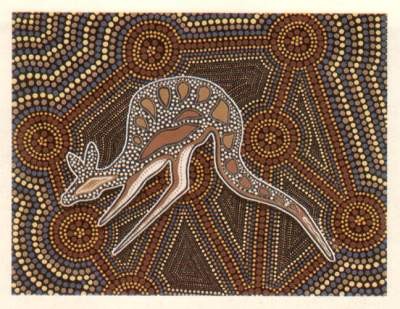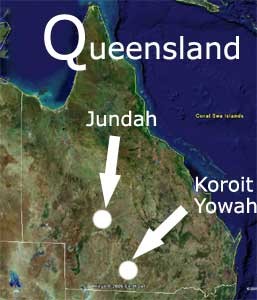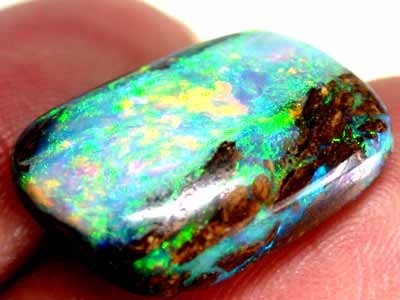从原住民神话传说到蛋白石故事 澳大利亚原住民与蛋白石产区的历史 
蛋白石与原住民的传说和神话有着强烈的精神联系。 据说,原住民祖先在蛋白石中留下了他们的存在。 阿德尼亚马坦哈族长老讲述了一个关于蛋白石形成的故事 
故事讲述的是一只名叫玛恩比的青铜翼鸽,它将一根点燃的木棍高高抛向空中。木棍落在库珀佩迪,落地时燃起火花和火焰,这些火花最终变成了蛋白石。 昆士兰 在19世纪80年代末先驱牧民和蛋白石矿工到来之前,昆士兰州大约有25个土著部落在这片土地上游荡。 
昆士兰州是一个幅员辽阔的州,东海岸拥有令人惊叹的热带雨林,内陆则是干燥的沙漠,拥有大片优质的牧场。 所有主要的蛋白石矿区最初都是由原住民命名的,他们过着游牧般的生活,欧洲殖民者称之为“漫游”。当地气候非常适合这种生活方式,即使在严酷干燥的沙漠中,原住民也熟知所有当地的水源,他们能够依靠富含营养的植物、幼虫以及袋鼠和鸸鹋等本土动物在贫瘠的沙漠中生存下来。 奎尔皮 Quilpie一词源自土著语“Quilpeta”,意为石鸻。 
君达 Jundah 是土著语,意思是“大鱼”或“大鱼之地”。 
库珀溪位于琼达以南,由汤姆森河和巴库河交汇而成,以盛产大型鱼类和当地鱼类而闻名。 基努纳 Kynuna是粉红凤头鹦鹉(Galah)的土著语名称。 奥帕尔镇 Opaltown 是梅恩赛德蛋白石矿区一个废弃的古老小镇,当地人也称之为“Quilpeta”,意思是石鸻。 科罗伊特、约瓦和尤洛 Koroit、Yowah 和 Eulo 的蛋白石矿区因出产蛋白石原住民艺术品而闻名,因为这些蛋白石具有与当地原住民艺术相似的天然图案。 这些蛋白石矿区靠近库纳穆拉镇,库纳穆拉在土著语中意为“大洞”或“水域”,与沃雷戈河有关。 Koroit是土著语中“泥水”的意思,该地区土壤以厚厚的粘土为主。
南澳大利亚 安达穆卡 Andamooka 最初被称为 Arndoo-moka',但这个名字很难发音,它源自土著语 Kuyani,与土著传统传说中承载重物或强大的骨头有关。 1872 年,巡视边界的骑手在地表发现了散落的蛋白石,由此引发了蛋白石热潮。 库伯佩迪 库伯佩迪原住民语“kupa piti”,通常被认为是“洞里的白人”或“洞穴里的白人”,因为新来的定居者为了躲避炎热而在地上挖洞居住。 1915 年,一些淘金者为了寻找水源而扎营,却意外地在地面上发现了蛋白石,并圈定了第一块矿地租约。 最初在 1920 年被称为斯图尔特山脉蛋白石矿区,后来由于镇上到处都是挖洞的白人,镇政府将其更名为现在的库伯佩迪。 明塔比 据说“Marla”一词源于原住民语,意为“袋鼠”。明塔比(Mintabie)曾是一个面积虽小但产量极高的蛋白石矿区。的确,如今仍有许多袋鼠在这片土地上漫步! 兰比纳 兰比纳蛋白石矿区于 1915 年被发现,该地区靠近库珀佩迪。 白崖是新南威尔士州最古老的蛋白石矿区,始建于 1889 年,但到 1914 年,蛋白石矿区已经开采殆尽,如今这个著名的蛋白石矿区出产的蛋白石非常少。
新南威尔士州 闪电岭 闪电岭以出产世界上最好的黑蛋白石而闻名。由于这片土地上经常遭受闪电袭击,因此得名“闪电岭”。其中最严重的一次闪电袭击发生在1900年,当时一道闪电击中了一只牧羊犬和600只羊,因此这座小镇被命名为“闪电岭”。 当地部落包括卡米拉罗伊部落和乌拉莱部落。 就连当地的街道 Morilla 也是以当地著名的原住民民间传说 Morillas 命名的。 
从一贫如洗到富甲一方,发现了“圣诞甲虫”,闪电岭闪光事件,以及1975年2月6日:距离上次听到有人真正挖到大金矿的故事已经过去很久了,以至于人们开始觉得那一切早已成为过去。上周五,这位不愿透露姓名的矿工只剩下最后的20美元。情况糟糕到他的车都抛锚了,他也没钱买零件。他完全不知道该怎么办。自1943年以来,他断断续续地在这里淘金,但八年前,他决定扎根于此,全身心投入到蛋白石开采中。 上周五,他和同伴下矿井继续一天的工作,结果意外地发现了一处美丽的蛋白石矿脉。其中有三颗品质极佳的宝石,美得令人难以置信,几乎难以估价。最大的一颗重达19克拉,形似一只璀璨夺目的圣诞甲虫,是笔者迄今为止见过的最美的宝石。它呈长椭圆形,略微隆起,拥有光谱中的所有颜色,但以红橙色为主,中心有一条淡淡的黑线,使其看起来像一只圣诞甲虫。它是黑蛋白石的完美典范。另外两颗也是美丽的黑蛋白石,同样品质卓越。其中一颗形状奇特,更添其魅力;另一颗则像杏仁一样大,底部略呈方形。 似乎没有人能准确评估这三件珍宝的价值。当然,每个见过它们的人都有自己的看法,有些人对其中两件的估价或许比较接近事实,但那件长得像圣诞甲虫的珍宝,简直是无价之宝。 1976年1月29日,闪电岭闪光报报道:一块价值5000美元的蛋白石散落在路上。即使如今有了重型机械和精密的采矿设备,仍然有人能捡到蛋白石。两个年轻人去闪电岭探亲,在安格尔杜尔路(Angledool Road)上,靠近尼比亚山(Nebea Hill)六英里路口附近,四处寻找化石。其中一个年轻人捡到了一块蛋白石。虽然它有颜色,但看起来并不特别。他觉得这块蛋白石可能值100美元。他把它拿给叔叔,叔叔帮他切割后,很轻松地就以5000美元的价格卖给了当地买家。这正好说明,很多游客都会问的那个问题——“你能在地上找到蛋白石吗?”——其实并非那么荒谬。 编辑兼“阿斯普”化石拥有者撰写的一篇迟来的文章。《闪电岭快讯》, 1977年12月28日: “阿斯普”是一块蛋白石化的蜥蜴腿骨,由瓦尔·博德曼(Val Boardman)和罗宾娜·博德曼(Robina Boardman)夫妇以及约翰·博尔顿(John Bolton)和瓦尔·博尔顿(Val Bolton)夫妇于1971年12月在剪羊毛工六英里矿区发现。当时,他们正在内维尔·贝尔(Neville Bell)发现“红知更鸟”(Red Robin)矿区附近的一处矿区清理表层泥土,瓦尔·博尔顿从泥坑里捡起了这块令人惊叹的化石。它长约一英寸,重达10克拉以上,是一块美丽的黑色晶体。这块化石被推荐给不同的买家。其中一位买家(我就不点名了)说它只值250美元,因为它切不出什么好晶体!为了确定它究竟是什么,照片被寄往世界各地,寄给知名的收藏家,甚至寄给了史密森尼学会。最终,澳大利亚联邦科学与工业研究组织(CSIRO)鉴定出它是一块蛋白石化的蜥蜴腿骨。 不幸的是,经济拮据迫使合伙人迅速评估财务状况,最终以1000美元的价格将这块蛋白石卖给了格伦加里的卡斯特罗。卡斯特罗是一位真正的蛋白石爱好者,他发誓永远不会出售或切割这块蛋白石,一直将其珍藏在保险箱里,直到几个月后发生了那场惊天盗窃案。彼得·马尔科姆,原籍三英里镇,被判盗窃保险箱罪名成立,保险箱里还装着许多其他贵重物品。马尔科姆声称他把这些贵重物品扔进了戈斯福德以北的奥林巴溪。很难相信有人会做出如此骇人听闻的罪行。 瓦尔·博德曼至今仍珍藏着由蛋白石摄影专家伦·克拉姆拍摄的众多幻灯片照片。阿奇·卡洛克里诺斯博士也十分珍视他拍摄的一张“毒蛇”蛋白石幻灯片,这张幻灯片清晰地展现了其鳞片,他有时会在专门的蛋白石幻灯片收藏展上使用它。“毒蛇”这个名字源于早期人们认为这块标本是史前蛇类的一部分,而这个名字也一直沿用至今。 
诺比矿难。闪电岭快讯, 1979年9月13日: 9月7日星期五上午8点54分左右,在鲍比矿区沃利·比格尔的矿井中发生了一起事故,导致两名男子受伤。当天上午,沃利和他的搭档沃利·鲁丁正在矿井中作业,当地教师伊恩·阿诺德、海因里希·米特和诺伯特·弗雷兹在一旁监督。当时正值学校假期,诺伯特和海因里希五月份刚从瑞士来访。沃利·比格尔独自一人在这个矿井工作了近十年。就在上周,他才找了个搭档,并决定负责矿井的这一部分。当时他们正在下到20英尺(约6米)深的地方清理一条旧巷道,一块砂岩从顶板掉落,砸中了伊恩,并将海因里希撞到了一边。 鲁丁立即寻求帮助,联系了艾哈迈德医生、卫生中心的护士和救援队。砂岩将伊恩压在地上,所幸附近的一堆碎石分担了大部分重量,而海因里希则被瓦砾撞到一边,设法脱身。沃尔格特救护车接到了电话,但救护车到达时,伊恩已经在卫生中心了。情况紧急,医生决定派遣皇家澳大利亚空军的医疗队乘坐一架专为紧急手术设计的加压飞机前来救援。一架来自里士满第36中队的C-130H大力神运输机于下午2:30抵达,下午3:50离开,机上载有14名人员,准备协助救治伤员。 截至发稿时,我们了解到伊恩·海因里希和海因里希均在皇家北岸医院接受治疗。伊恩下颌骨骨折,海因里希疑似背部骨折。伊恩23岁,海因里希28岁。 发现鼠洞入口,闪电岭闪电, 1980年3月20日:大多数人都知道,“偷矿者”指的是那些非法进入其他矿工矿井,以夜班工人的身份作业的人。有些偷矿者被抓获并处以重罚,但上诉后罚款却被减至微不足道。看来我们的法律体系亟需改革,至少在对偷矿者的定罪方面是如此。这种犯罪不仅仍在继续,而且在闪电岭似乎正在演变成一项规模庞大且危险的“生意”。最近一起案件发生在矿主度假期间。临行前,他们用木头封住了矿井,在入口处放了一个铁皮罐,并用蛋白石泥土覆盖,使其看起来像一个废石堆。但偷矿者发现了这个伪装,并找到了入口。完事后,他们用一扇旧门盖住了入口,并在周围堆满了泥土,从外面看,就像是游客挖过土堆一样。 在波奇角矿区工作的帕特·麦克尔莱恩和雷·恩克莱门特度假回来后发现了这起入室盗窃案。窃贼把梯子留在矿井里。自从山顶发生罢工以来,波奇角矿区的所有矿工都对窃贼感到担忧。一些矿工加强了巡逻,而另一些矿工则睡在卡车里守卫自己的矿区。两名矿工甚至用卡车盖住了他们的矿井,结果第二天早上发现卡车被挪走了。据说有些人知道窃贼是谁,但害怕遭到报复,所以不敢指认。 在闪电岭,矿工们靠开采蛋白石勉强糊口本就十分艰难。自从机械化开采引入矿场,运行成本飙升之后,对于那些运气不佳的矿工来说,日子更是难上加难。有些人经过多年的辛勤劳作,终于找到了蛋白石或优质的矿脉,但偷窃者始终存在,而且往往能抢走最好的部分。如今,由于许多家庭生活拮据,偷窃者的处境岌岌可危。对已定罪的偷窃者,罚款并非解决之道;或许只有将他们驱逐出矿区并判处重刑,才能真正遏制这种猖獗的现象。 伪造银行支票。《闪电岭快讯》, 1981年12月24日:本周,矿工们侥幸逃过一劫,免遭蛋白石被盗。三名男子因使用伪造支票被捕。当地银行会计特里·亚伯拉罕发现两张支票号码相同,于是报警。当时,有人给矿工们开了总额为10万美元的支票。就在蛋白石买家在保龄球俱乐部被捕后半小时,还有其他交易安排。两名同案犯匆忙逃离小镇,在沃尔格特的一个路障处被捕。这三名男子将于本周在沃尔格特出庭受审。 
矿工遇难。闪电岭闪电事故, 1984年7月24日: 7月5日星期四,42岁的伊格纳克·哈齐克(Ignac Hazic)的遗体在四英里深的山区被发现。哈齐克是闪电岭(Lightning Ridge)的一名蛋白石矿工。前一天,附近作业的矿工注意到哈齐克的设备,第二天他们返回时发现设备没有移动,怀疑出了问题,于是报警。救援人员花了三个半小时才将他从坠落处救出,他们不得不在极其危险的情况下支撑并切割大块砂岩才能接近他。据估计,他至少在那里待了36个小时。 矿工杀死小牛。闪电岭快讯, 1985年2月14日:多年来,总有一些人擅自前往洛恩牧场购买肉类。一月初那场猛烈的雷暴过后,第二天我们就发现一头小牛犊四肢被砍断,这的确令人痛心。如今,我们也面临着入不敷出的困境,当一头珍贵的牲畜被如此残忍地宰杀时,我们更是倍感惋惜。多年来,我们一直帮助那些生活拮据的人,从不拒绝任何人。但当目睹如此骇人听闻的事件发生时,人们不禁会想,究竟是谁,在我们中间,竟会做出如此恶行。 
哈雷彗星的发现。闪电岭闪电, 1986年6月19日:当地一个被称为“疯子山辛迪加”的矿工团体发现了一块重达2200多克拉的巨型黑蛋白石原石!他们声称这是现存最大的蛋白石原石,并将其命名为“哈雷彗星”,因为这颗彗星将在几周后出现在我们的夜空中。这块巨大的蛋白石实际上是在1985年10月被发现的,但直到本月初它出现在国家电视台的节目中,这笔价值六百万美元的发现才公之于众。 疯人山辛迪加的一位发言人表示,这块小山丘上嵌着一颗宝石级的橙绿色黑蛋白石。业主们表示,他们希望澳大利亚政府能够购买这颗宝石,作为二百周年庆典的一部分。这颗宝石几乎和成年男子的拳头一样大。 昆士兰州发现罕见蛋白石1885年,帕尔默河地区新发现了一处金矿,那里挤满了形形色色的人,包括探矿者、矿工、店主和华人。鼎盛时期,矿区里大约有3万名白人矿工和2.5万名华人。 粮食短缺,一大群牛被赶来供应牛肉。这些牛属于南部殖民地温多梅尔牧场的德尔帕德家族。年轻的英国人克莱门特·泰瑞尔正在帮助德尔帕德一家及其两个女儿露西和劳拉经营牧场。在昆士兰西南部蛋白石矿区开发期间,昆士兰北部山区意外发现了一块美丽的火山蛋白石。泰瑞尔踏上了长达一千多英里的旅程。一天,阳光下似乎有什么东西闪了一下,他走近后,发现地面上闪闪发光的东西。他蹲下身子捡了起来,发现那是一块巨大的蛋白石,形状像一座房子的屋顶,大约两英寸长,半英寸宽。泰瑞尔手中的这块蛋白石闪耀着红宝石、托帕石、祖母绿和蓝宝石混合的光芒。 神秘的蛋白石矿工——卡尼·吉米大约一百年前,昆士兰西南部有一位吝啬的老蛋白石矿工,他连肉都不舍得买。他会把蜥蜴拴起来吃。据记载,他甚至在自己的坐骑老马死后,用盐腌制后吃了它。他是个苏格兰人,也是个守财奴,历史上只知道他叫“卡尼·吉米”。“卡尼”是丛林人对一种叫作褶颈蜥蜴的称呼,这种蜥蜴是他的主要食物之一。据说,他是在与原住民一起生活时学会吃这种蜥蜴的。 吉米守口如瓶,从不透露他从矿里赚了多少钱。即使到了今天,仍然有人相信卡尼·吉米的矿区里埋藏着一笔巨额财富。他是所有在蛋白石矿里干活的人中最沉默寡言的,尽管有传言说他受过良好的教育。他从不主动透露自己的信息,但只要他允许别人喜欢他,大家都喜欢他。 他的口音暴露了他的苏格兰血统,他收到的信件也全部来自苏格兰,但无人知晓寄信人是谁。他还订阅苏格兰报纸,并对他的故土表现出浓厚的兴趣——事实上,他对故土的兴趣远胜于对澳大利亚的兴趣。他的矿场“小奇迹”出产了大量的水晶蛋白石。自从卡尼·吉米的矿权并入后,矿工们一直认为他也发了大财。他丝毫不羞于承认自己以蜥蜴为食,事实上,他常说蜥蜴能让他精力充沛。 他从不买肉、蛋或面粉,但一年一两次会买点米和茶叶。到了季节,他会去吃巨蜥蛋,还会煮猪肠,他管猪肠叫“野甘蓝”。吉米据说运气很好,而且他的确很勤劳。他和别的矿工最大的不同之处在于,他总是独自工作。 令所有人惊讶的是,他竟然接受了与乔·布里德尔合伙开矿的提议。他们一起开垦了一座新矿——黄内尔矿。有一段时间,吉米过上了相对正常的生活,吃着烤饼,甚至还吃着培根煎蛋。矿脉里出产了一批不错的蛋白石,布里德尔以280美元的价格卖掉了自己的那份,但卡尼却一直留着。他从来不卖蛋白石。矿脉枯竭后,卡尼又回到了他孤独的生活,和他的拴着的蜥蜴们相依为命。 人们对卡尼的秘密充满了好奇,以至于经常有人对他严加监视。没人想偷他的蛋白石,至少在他还活着的时候没人想,他们只是想知道它的下落。他如此神秘,以至于许多矿工常说,只有沙漠之星和澳洲野狗才知道他把宝藏藏在哪里。 夜里,卡尼的矿区似乎会传来奇怪的声响。最常见的声音是镐头敲击砂岩的闷闷闷响。经常有人趁着夜色偷偷摸摸地靠近,想看看发生了什么,但当他们靠近卡尼的矿区时,那些声音就会消失。如果卡尼听到了什么动静,那他一定是听力超群。更有可能的是,他有一种第六感,能预感到有人在暗中监视他。然而,通常情况下,当入侵者离开后,那沉闷的声音又会再次响起。 卡尼还经常骑着他那匹奇特的马进行神秘的夜行。田野里的人们都认为他是在夜里带着蛋白石去赴约。卡尼的马是一匹野马,血统早已断绝。它几乎没有毛,也没有牙齿,在某些方面,它的生活轨迹与它的主人颇为相似。 和卡尼一样,他的马也是某天早上突然出现在田野里的。没人知道它从哪里来,卡尼也从未透露过任何信息。这匹马以前从未到过这片地区。通常,卡尼会把马拴在离营地15公里远的地方,偶尔才会把它带回营地。卡尼总是在夜里骑着它进行这些奇怪的旅程。他是去卖蛋白石,还是去藏匿蛋白石?没人知道答案。无论他走到哪里,他的藏身之处都不在附近,有时他会一走就是三四天。有几个人试图追踪他,但都失败了。 最终,一天晚上,那匹马死了。人们说它早就没用了,卡尼·吉米把它杀了充饥。可以肯定的是,就在马死前后,卡尼的饮食习惯发生了改变。一大堆腌肉被晾晒在金合欢树丛间。卡尼声称那是袋鼠肉,但老手们说那是卡尼的马肉。 他没能比他的马活得更久。彼得·努拉是一位土著人,他似乎比任何人都更了解卡尼。努拉发现卡尼躺在营地附近的地上。卡尼告诉努拉,他被蛇咬了,但会没事的,因为努拉要泡一杯浓草药茶,能“治好他”。卡尼死在他平时拴马的那丛金合欢树附近。 这位沉默寡言、神秘莫测的苏格兰人的故事就此结束。人们对他宝藏的好奇心却始终未减,他刚一入土,他的营地就被翻了个底朝天,引发了一场疯狂的寻宝热潮。卡尼把宝藏藏得很好,至今无人找到。如今,只有沙漠中的星辰才知道它藏身于那片荒凉、野狗出没的山丘之中。 | 









